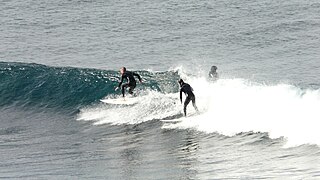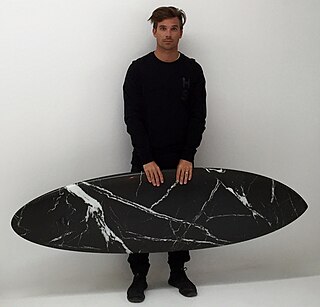
Surfing is a surface water sport in which an individual, a surfer, uses a board to ride on the forward section, or face, of a moving wave of water, which usually carries the surfer towards the shore. Waves suitable for surfing are primarily found on ocean shores, but can also be found in standing waves in the open ocean, in lakes, in rivers in the form of a tidal bore, or in wave pools.

A surfboard is a narrow plank used in surfing. Surfboards are relatively light, but are strong enough to support an individual standing on them while riding an ocean wave. They were invented in ancient Hawaii, where they were known as papa he'e nalu in the Hawaiian language, and were usually made of wood from local trees, such as koa. They were often over 460 cm (15 ft) in length and extremely heavy. Major advances over the years include the addition of one or more fins (skegs) on the bottom rear of the board to improve directional stability, and numerous improvements in materials and shape.
Rip Curl is a designer, manufacturer, and retailer of surfing sportswear and accompanying products, and a major athletic sponsor. Rip Curl has become one of the largest surfing companies in Australia, Europe, South America, North America and South Africa. Globally, Rip Curl is considered a successful member of the "Big Three", of the surf industry alongside Quiksilver and Billabong.

Surf culture includes the people, language, fashion, and lifestyle surrounding the sport of surfing. The history of surfing began with the ancient Polynesians. That initial culture directly influenced modern surfing, which began to flourish and evolve in the early 20th century, with its popularity peaking during the 1950s and 1960s. It has affected music, fashion, literature, film, art, and youth jargon in popular culture. The number of surfers throughout the world continues to increase as the culture spreads.
Martin "Pottz" Potter, is a former professional surfer.

Simon Anderson is an Australian competitive surfer, surfboard shaper, and writer. He is credited with the 1980 invention of a three-fin surfboard design, called the "thruster".
Danielle Foote, born 8 June 1987 in Adelaide, is an Australian former reality series star and business person. She appeared on Big Brother Australia 2006 and lived in Sydney. Her debut single, a cover of Underworld's "Underneath the Radar", was released on 7 August 2006. It debuted at No. 52 on the ARIA singles chart, and peaked at No. 41. In January 2015 Foote married Hayden Cox, an Australian surfer and board designer. From 2014 Foote has worked with Cox in his board design business in El Segundo, California.

The riding of waves has likely existed since humans began swimming in the ocean. In this sense, bodysurfing is the oldest type of wave-catching. Undoubtedly ancient sailors learned how to ride wave energy on many styles of early boats. Archaeological evidence even suggests that ancient cultures of Peru surfed on reed watercraft for fishing and recreation up to five thousand years ago. However, standing up on what is now called a surfboard is a relatively recent innovation developed by the Polynesians. The influences for modern surfing can be directly traced to the surfers of pre-contact Hawaii.

John "John John" Alexander Florence is an American professional surfer. He is known as "one of the most dominant pipe surfers of his era" and won back-to-back world titles on the 2016 World Surf League and 2017 World Surf League Men's Championship Tour. He is the first Hawaii-born surfer to win back-to-back world titles since the late Andy Irons. Florence qualified to represent the United States at the 2020 Summer Olympics in surfing. He qualified for the 2024 Olympic Games.
Bob McTavish is an Australian surfboard designer and member of the surfing hall of fame.
Piping Hot is an Australian surf and street clothing brand. It was established in 1975 by Fred Pyke and Rod Brooks in Torquay, Victoria.

A surfboard fin or skeg is a hydrofoil mounted at the tail of a surfboard or similar board to improve directional stability and control through foot-steering. Fins can provide lateral lift opposed to the water and stabilize the board's trajectory, allowing the surfer to control direction by varying their side-to-side weight distribution. The introduction of fins in the 1930s revolutionized surfing and board design. Surfboard fins may be arrayed in different numbers and configurations, and many different shapes, sizes, and materials are and have been made and used.

Finisterre is an outdoor apparel and surfwear company with a focus on functional and sustainable products. Based in St Agnes, Cornwall, and founded by Tom Kay in 2003, they are recognised as a cold water surf company.

Australia is renowned as one of the world's premier surfing destinations. Surfing underpins an important part of the Australian coastal fabric. It forms part of a lifestyle in which millions participate and which millions more have an interest. Australian surfboard-makers have driven innovation in surfboard design and production since the mid-1960s. The country has launched corporate giants such as Billabong, Rip Curl and Quiksilver.
Cyrus Sutton is an American director and professional surfer. Growing up in Southern California and dividing his time between the coast and mountains, Sutton's inventive approach to filmmaking became the basis of the outdoor surf website Korduroy.tv Growing up near the ocean and participating in water sports such as body surfing, bodyboarding and surfing, he sought to use cinematography to document the surf culture around him and on his travels. His commercial clients include Adidas, Apple, Corona, Reef, and Patagonia. His career has been well documented by various national publications such as Surfer Magazine and The New York Times.
Christo Hall is an entrepreneur, ex-professional surfer, author and owner of a marketing agency.

Surfing in the United States is a popular hobby in coastal areas, and more recently due to the invention of wave pools, inland regions of the country. It contributes to a lifestyle and culture in which millions participate and which millions more have an interest. USA surfing is the governing body for the sport of surfing in the United States, with surf leagues such as the World Surf League available in the country. Surfing can be traced back to 17th Century Hawaii and has evolved over time into the professional sport it is today, with surfing being included for the first time in the 2020 Summer Olympics in Tokyo.

Hayden Cox is a surfboard designer, entrepreneur and founder of Haydenshapes Surfboards. He is also the inventor of patented parabolic carbon fibre frame surfboard technology FutureFlex sold globally, along with his brand Haydenshapes, in over 70 countries. He is recognised for his innovative use of custom designed materials, modern construction methods and entrepreneurialism in business
Rusty is an Australian surfboard and surfwear brand formed in 1985 by Rusty Preisendorfer. It also operates in the US under the name Rusty Surfboards.











